Private Pier — Fishing License Required
Paradise Cove’s pier is an icon of its history. Over decades of fishing boats, strolling lovers, angry storms, determined rebuilds and fat seagulls, it’s remained a landmark for this latitude of coastline. It used to be about twice as long, until nature decided otherwise one dramatic winter back in the early 80’s. For years I’ve stepped lightly across these planks as I did today. One’s nose is immediately greeted with that distinctive Eau de Pier scent: moldy-salty-smoky creosote marinated in the collective sun-baked guano of sea birds… no wonder hot dates can’t keep their hands off each other when they get here. My oddest pier-specific memory is of one New Years Day walking with a few friends. Upon reaching the tip, a girlfriend who worked at Paramount Studios suddenly removed her left sneaker and flung it far out to the sea. When quizzed on this, she replied, “tradition!” Perhaps she wasn’t the first in her family to be in shoe business.” —Alex Shapiro, Objects are closer than they a pier, November 3, 2006, notes from the kelp, (http://www.alexshapiro.org/blog/?p=123)
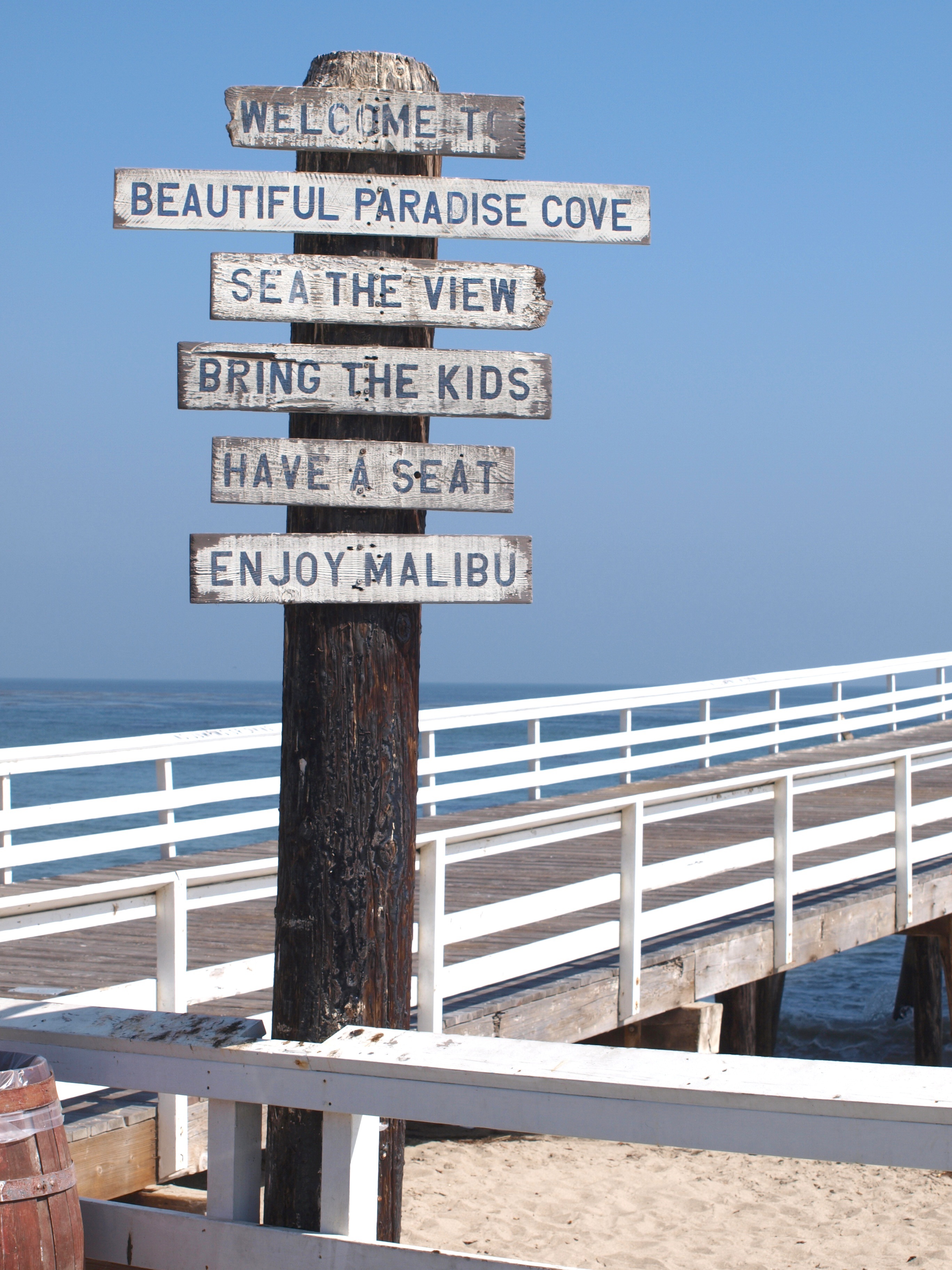
If you have the dough and a fishing license, and you want to try something different, you can try this little pier that is located in a private cove and beach. Jacketed attendants let you into the parking area for a $45-65 per car charge, although you can walk in for less, and then you’re entitled to use the beach or pier.
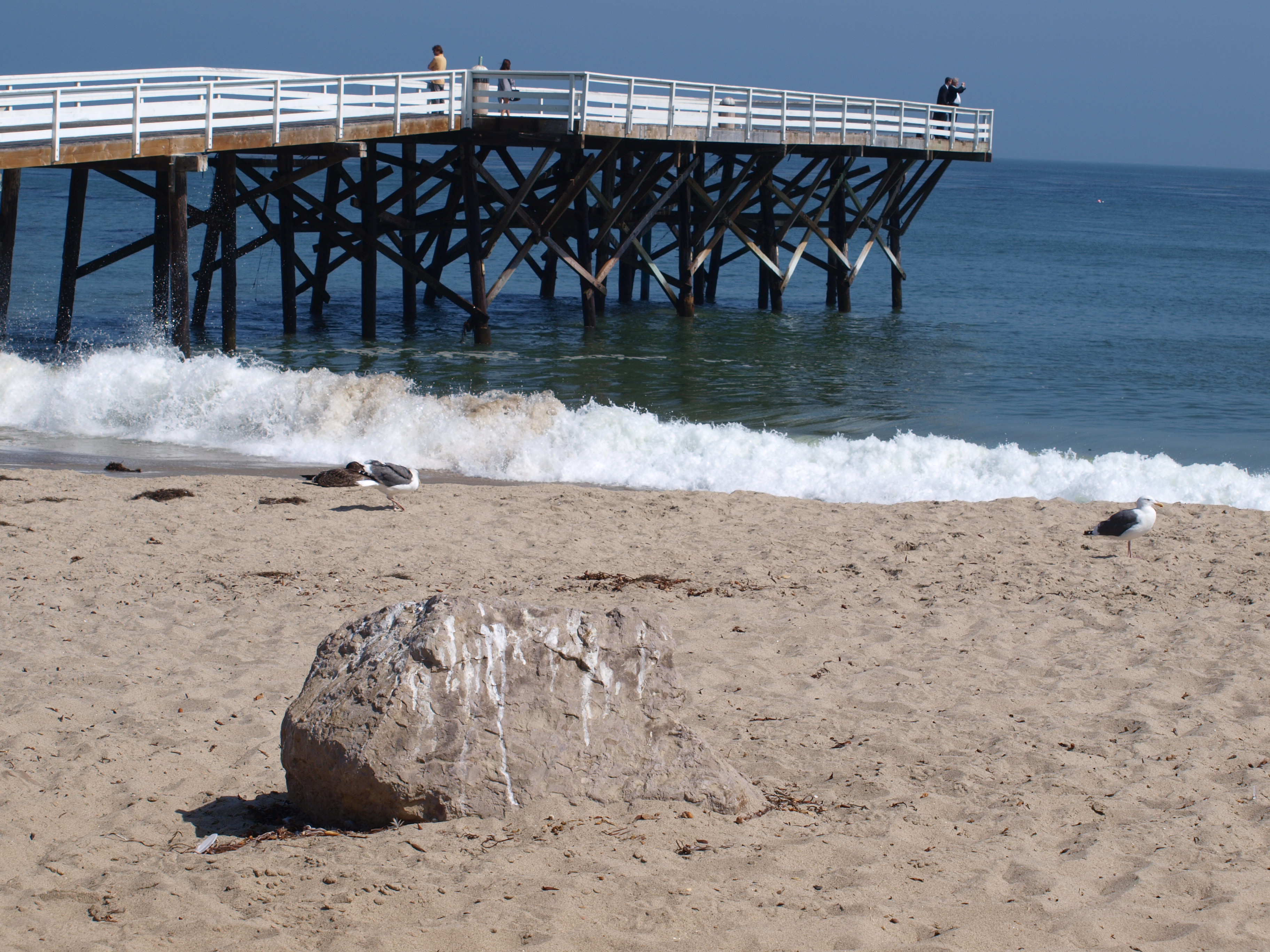
Of course, the pier today bares little resemblance to the pier that existed before the storms of 1983. Prior to that year, a 600-foot-long pier graced the cove’s waters. The pier was well maintained, had rental boats, and the Paradise Cove Sportfishing fleet operated from the pier. Today, that is all gone. The El Niño-driven winter storms of 1983 that damaged so many piers included this pier as a victim. Huge waves destroyed much of the pier and left only a small 220-foot-long, inshore section intact.
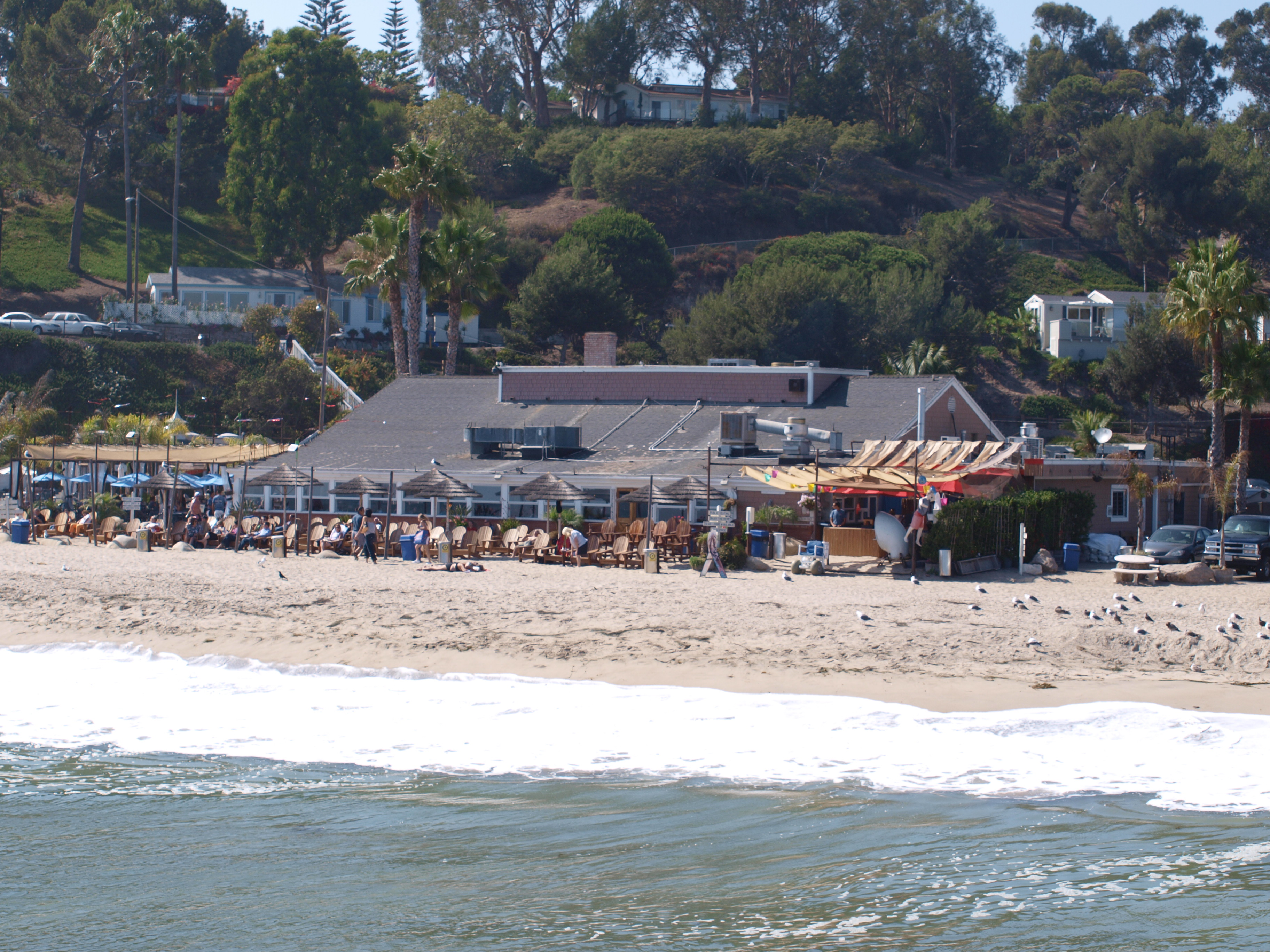
You can pay $10-15 to park for four hours if you spend at least $30 at the cafe.
Although still in use until the year 2000, it was closed for a period of time but is now once again open. Good news because this is a popular although pricey and pretty area. It is a site that has been used in many movies, television films, and commercials, and is a pier that, at one time, had better-than-average fishing. Even given its reduced size, it still manages to offer decent to good fishing and, at times, offers an interesting variety of species.
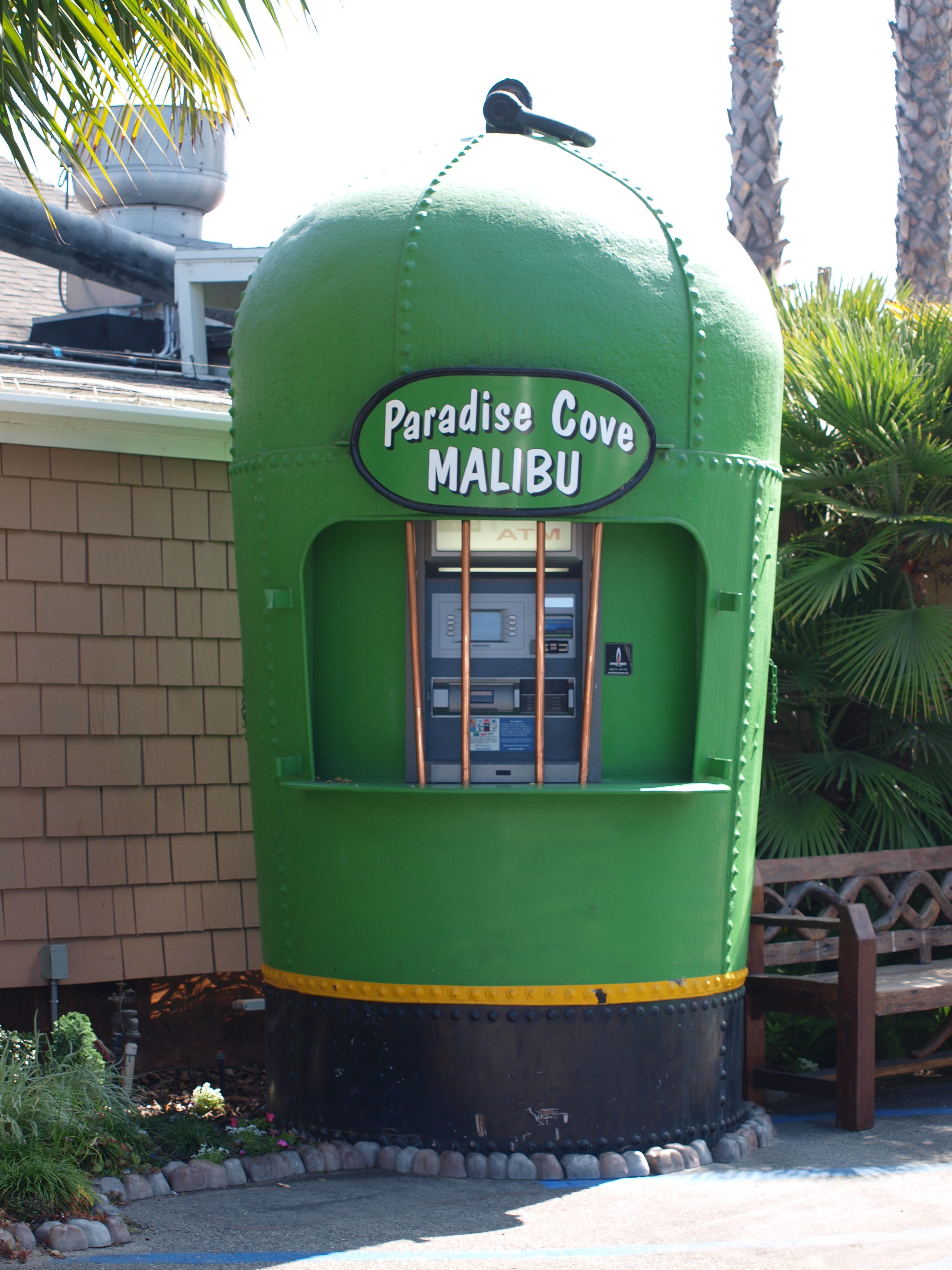
Environment. Paradise Cove is located just south of Point Dume, the northern end of Santa Monica Bay, and has long been a favored destination for boaters and fisherman. Wind and waves can be somewhat deflected by the point, and the area is known for large growths of kelp, conditions that attract the fish—and fishermen.
The pier sits in fairly shallow water, the bottom is primarily sand, pilings have some growth of mussels, and, during the summer, the pier itself is often thoroughly surrounded by a luxuriant garden of kelp and seaweed. Because of the light surf, the area usually had only fair surf fishing (although some surfperch and corbina are caught). However, because of the extensive beds of kelp and other assorted algae that often surround the pier, there can be a pretty fair variety of kelp-loving species available to anglers who know how to catch them. The numbers are usually not that high but an angler is often able to get a surprising variety of fish and a few good quality fish.
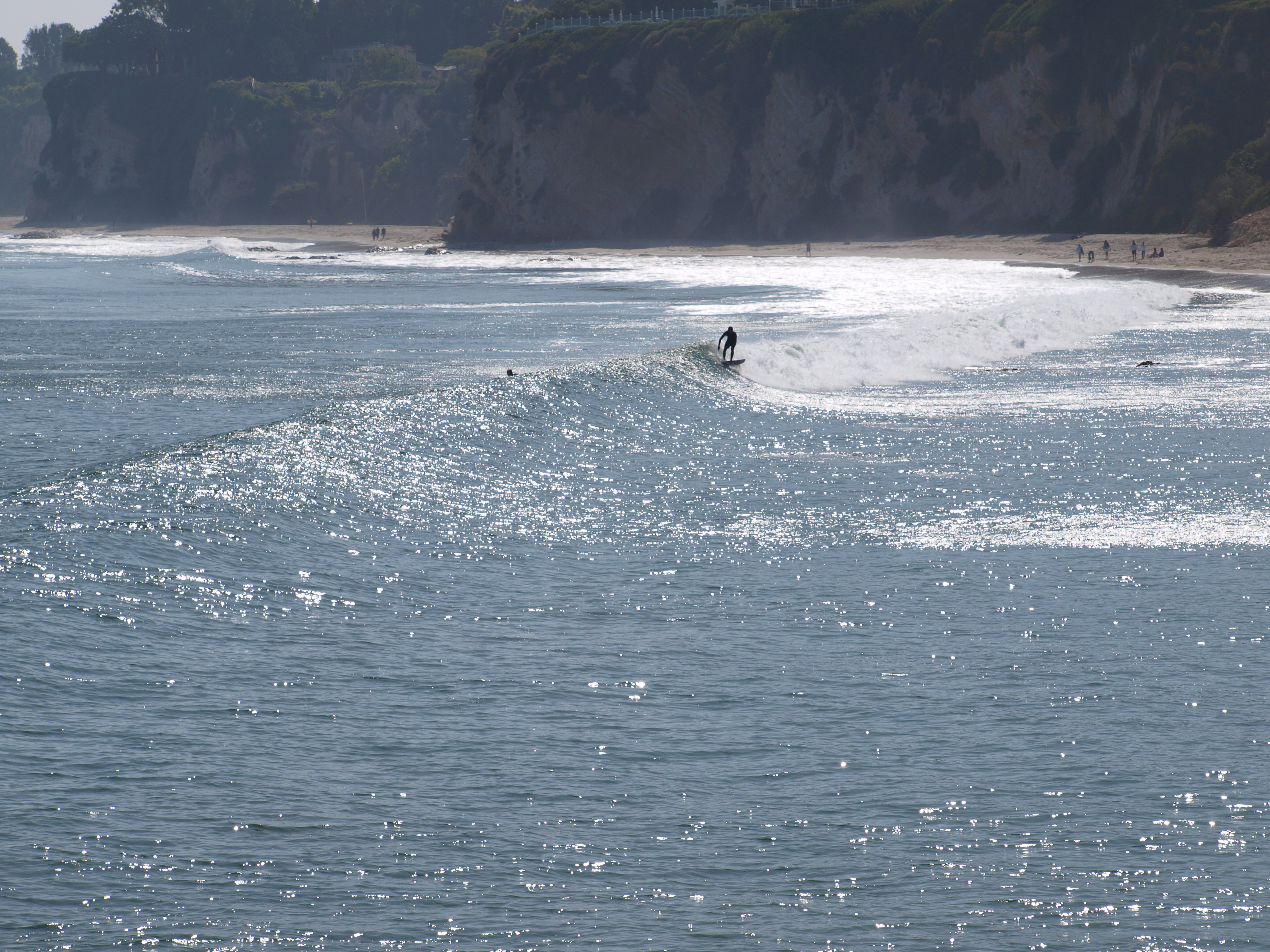
Fishing Tips. Normal southland baits and procedures work here: sand crabs, sea worms, mussels and ghost shrimp in the surf area, live bait, cut anchovies, cut mackerel, and strips of squid further out on the pier.
Inshore, anglers primarily land barred surfperch, corbina and several types of croaker. I’ve never thought the pier was particularly good in the surf but I’ve been told by some regulars (not seen it) that the surf fishing is just as good as at the Malibu Pier. Artificials will work here as seen by the regulars using grubs for perch.
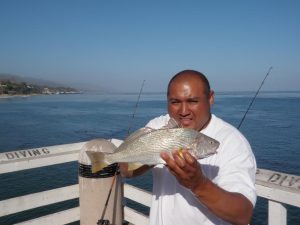
Yellowfin croaker
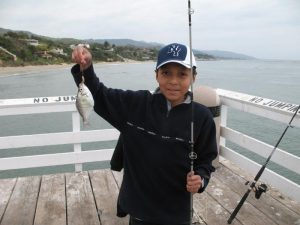
Walleye surfperch
Just past the breakers all the way to the end (because the pier is short) is the area for halibut. At times, especially spring to early summer, quite a few halibut are caught. Anglers fishing plastics such as Big Hammers or Fish Traps take most of the flatfish but the vast majority of the fish are under the legal size. In fact, I watched an angler during a visit in June of 1995 land over a dozen flatties in just over an hour using plastics but not one was more than about 15 inches in length. Live bait will also attract the halibut and a small perch or white croaker used as bait will generally see larger fish than the plastics. Try using a Carolina rigging or a live bait leader a couple of feet above a sinker.
Way, way back, when the pier was much longer, in January 1967 to be exact, a 35-pound halibut was caught from the pier by William Cambier. The picture of the fish and the details of the catch made the newspaper
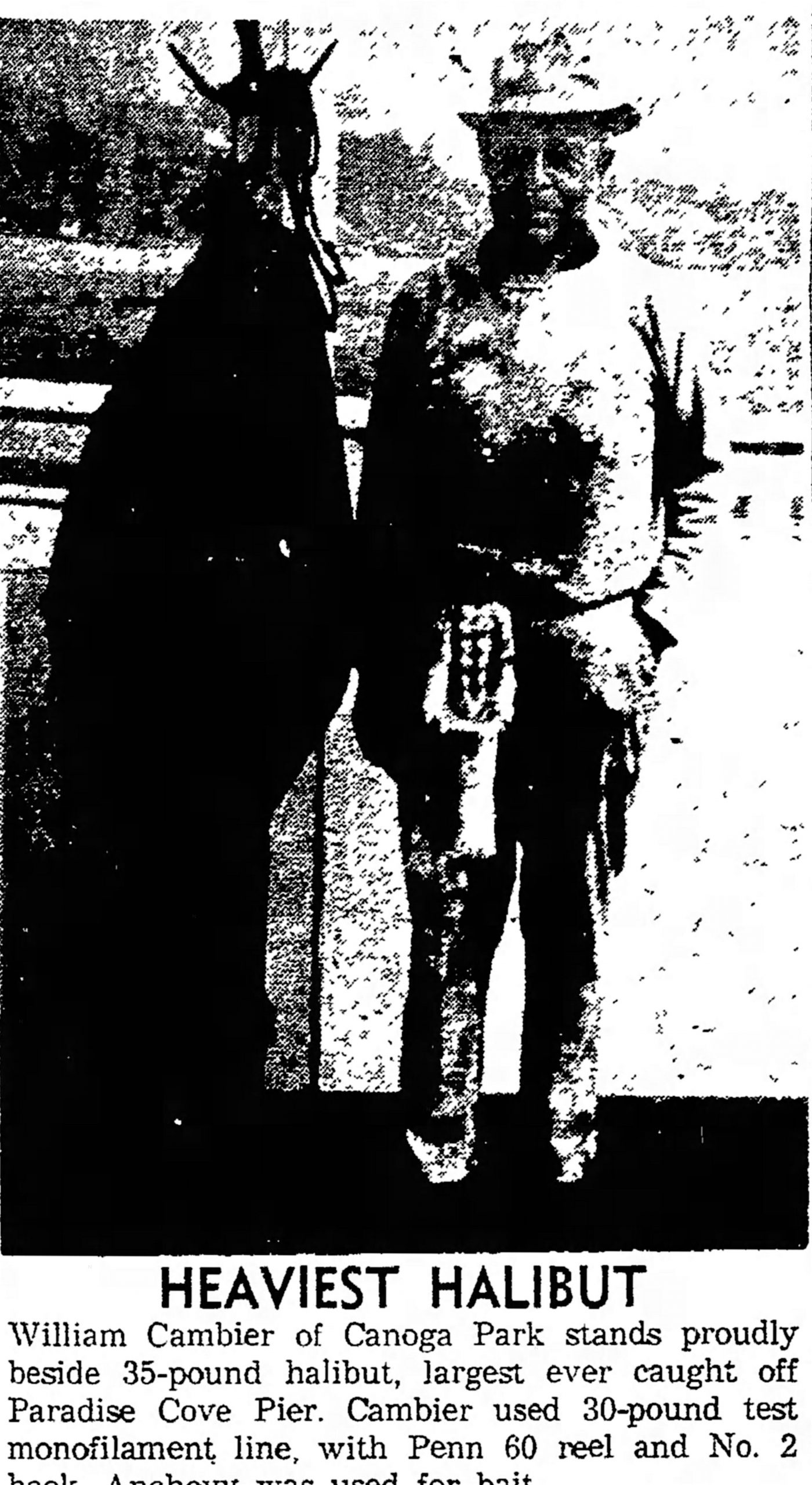
“By the way, this may be an early season spot for halibut. Normally the SoCal halibut season kicks off around the start of May but here it may start sooner. The sand beaches of the Malibu, stretching from the movie colony pier to above Point Dume fishing grounds are noted for their late winter and early spring runs of the flatfish family and the jump in results of this species over the weekend could be the opening round of the first major show of halibut for the season.”—Van Nuys Valley News, February 7, 1967
Mid-pier to the end can see invasions of jacksmelt as well as a plethora of bottom species—thornbacks, shovelnose sharks (guitarfish), leopard sharks and bat rays. At the end of the pier, anglers have the best chance of encountering the pelagics—Pacific mackerel, jack mackerel, sardines, and sometimes bonito, but the numbers are less than at longer piers that extend further out into deeper waters. Surprisingly, the fairly shallow waters have yielded some pretty good-sized fish including a 3-foot-long black (giant) sea bass taken in July of ’08 and a 37-inch white seabass taken in March of 2009.
As mentioned, the pier sometimes has a heavy growth of seaweed and kelp during the summer to fall months, vegetation that provides excellent cover and attraction for several varieties of fish—including some that are infrequently encountered at the area’s other oceanfront piers. Halfmoon, opaleye, blackperch, sargo, giant kelpfish, striped kelpfish, senorita, rock wrasse, sand bass, kelp bass, and small rockfish—kelp rockfish, grass rockfish, or olive rockfish (Johnny bass)—all are fairly common when the kelp is around.
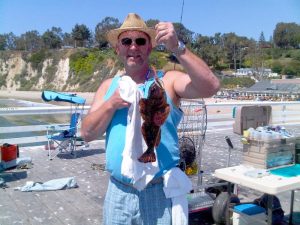
Cabezon
I’d bring along some bloodworms (or lugworms), fresh mussels, and shrimp (especially live ghost shrimp) to try for these species. Bring along some frozen peas or moss if specifically seeking out the opaleye. Fish on the bottom or mid-depth and use only enough bait to cover a size 6 or 8 hook.
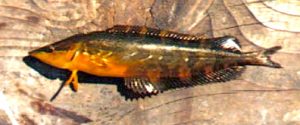
Giant kelpfish
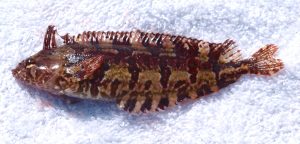
Striped kelpfish
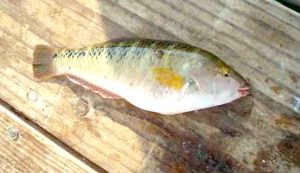
Rock wrasse
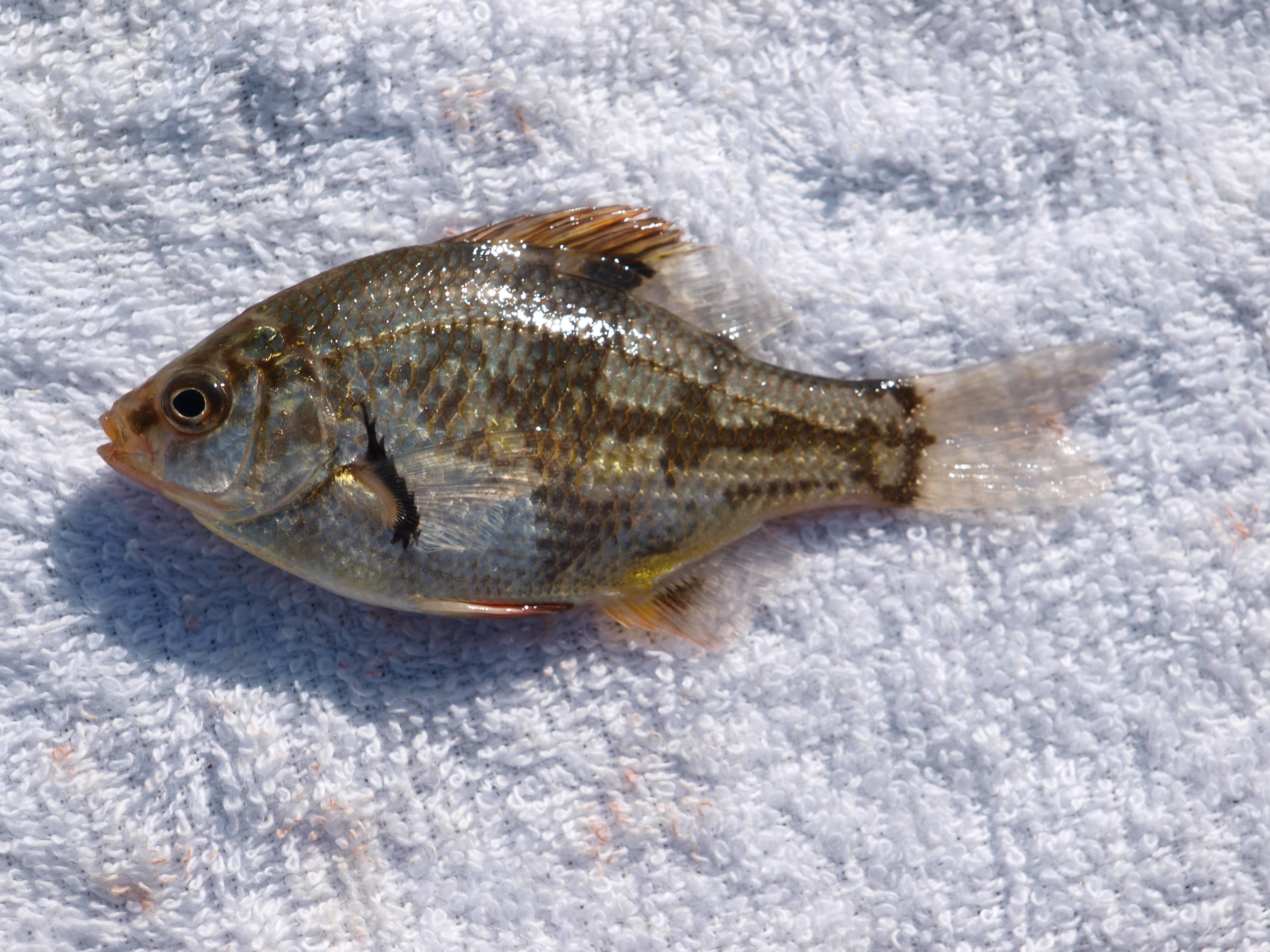
Dwarf Perch
Regulars (including some of the men who worked on the Rockford Files) told me that the pier used to be a top opaleye pier and good strings of fish were a possibility. However, that was when the pier was considerably longer.
The pier is not noted for sharks (primarily because it is only open during daylight hours). Nevertheless, a lot of big bat rays are taken. If fishing for the large leopard sharks or shovelnose guitarfish try live bait or a smelly piece of mackerel. If seeking out the large bat rays try a large piece of squid. The bat rays in particular can be hard to land when the kelp is thick around the pier.
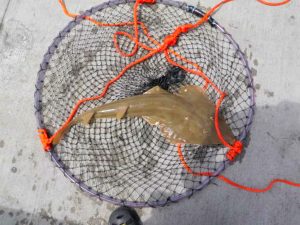
Shovelnose shark (guitarfish)
A non-fish species that is frequently encountered is spiny lobster. Do remember that they must be taken by net, they have a legal size and season, and you must have a lobster card to keep them. At most piers you primarily see lobsters at night but this area seems to have enough of the bugs to even see them during the day.
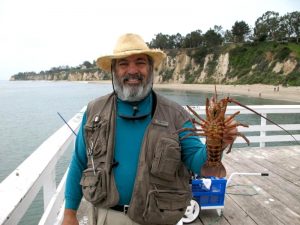
Spiny lobster caught by Mahigeerr aka Hashem Nahid
Water clarity can be a problem here; it is fairly shallow and on many summer days it is crystal clear. On such days, the lighter the line and less hardware the better are your chances—so use fluorocarbon as leader material or even as your main line.
The Pier Rats Speak
Date: July 6, 1999; To: Pier Fishing in California Message Board; From: JP; Subject: Paradise Cove Pier
On Monday, the 5th, my boyfriend and I went down at Paradise Cove around 12 PM to do some pier fishing. We had only been there about 2 hours when an officer came strolling down the pier checking fishing licenses. Luckily I had mine in the car from two days before when we were fishing down in Dana Point and San Clemente…I didn’t think you needed a license for pier fishing—and you don’t, for most piers. But, since Paradise Cove is a private beach and pier, they require a license. Not only did this officer check licenses, she checked every single cooler and bucket and made everyone claim their rods (yep-she was enforcing the 2 rod/person limit. And rightfully so! Between two men, they had 11 rods in the water. Too many for a pier this size! It makes it hard for anyone else to get a good cast in, let alone a good catch.) Additionally, any unclaimed rods she reeled in and tried to take with her; until the owners finally fessed up…a few without licenses, and a few with more than two rods in the water. And guess what? She ticketed every one of them! So remember next time you painfully fork over $20 to park at Paradise Cove for some pier fishing, you take your license and your two favorite rods. OKAY, here’s the meat: We were there for 4 hours and got a few nibbles from small mackerel and opaleye. The two with 11 rods caught quite a few perch, sargo and sculpin…and tickets from officer Kathy, of course.
Date: October 21, 2004; To: PFIC Message Board; From: Rockfish59; Subject: Movie question
I was wondering if any of the old timers here may remember a movie that came out around the late 50’s/early 60’s or so and it was about a kid who fished on a pier and the plot revolved around catching a huge fish that was supposedly ‘uncatchable.’ I remember one part where there was an old fart who would move in on someone’s ‘hot spot’ if they left it for a few seconds. It was in black and white and I also remember that Jerry Lewis sang on the sound track about the kid. I checked Lewis’ biography but didn’t see any mention of the film.
Posted by pescare
Raymie – 1960. Really cool movie about a boy fishing for that illusive “big fish.”
From the movie page: Classic 1960’s Hollywood production, filmed almost entirely on location at the beach, instead of on a sound stage. Released only in B&W; runs about 72 minutes. Stellar performances by John Agar, Julie Adams, Charles Winninger, Richard Arlen, young David Ladd as “Raymie.” The title song was sung by none other than Jerry Lewis. This was Charles Winninger’s last movie before he passed away.
Posted by dompfa ben
This sounds like a “Must Rent”… maybe a “Must Own!” Just like “Mr. T’s-Be Somebody (Or Be Somebody’s Fool),” and “The Star Wars Christmas Special” According to IMDB, Richard Ladd played the voice of Fletcher in Jonathan Livingston Seagull…one of the worst movies (and greatest books) of all time…
Date: July 3. 2008; To: PFIC Message Board; From: HUNTRESS; Subject: Look what came to visit…a Giant (Black) Sea Bass
July 2 was a gorgeous southern California day, light variable winds, afternoon low tide, evening high tide with a grunion run expected (never saw any grunion where I was fishing). What I did see/catch was 4 Calico bass (1 legal, 3 short), 2 leopard sharks (1 legal, 1 baby), a tiny shovelnose, 1 brown smoothhound, and this … check out the pics! All were caught on half-sardines using circle hooks; ALL fish were released. Later after sunset, the water was full of activity, but every hit severed the line (80lbs test braided leader) so I can only assume they were large toothy sharks! Altogether a fantastic So-Cal day by the water. Sorry I don’t have a weight on the Giant Bass, but he was an inch or so over 3 feet, and it took two of us to lift him over the rail for the release… Truly a magnificent creature! … The fish was released with the net, and the pics were snapped by a kind tourist while I was working on getting the hook out and releasing it, the fish was never “handled” in any way, except for pliers to the hook, so I feel all was done as efficiently as possible to expedite the release.
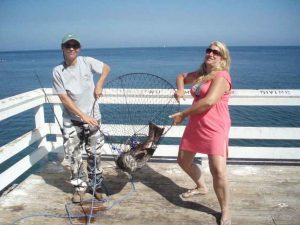
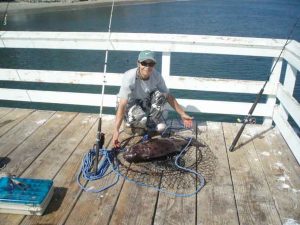
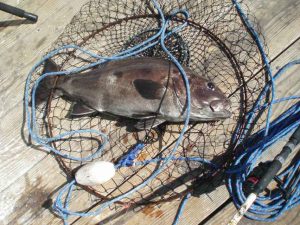
Potpourri — Probably More Than You Want To Know About The Paradise Cove Pier
<*}}}}}}}}}>< — Two record fish were caught in the cove. For more than 30 years, the state record sheephead was a fish weighing 28 lbs. 14 oz. that was taken in Paradise Cove on December 6, 1978. In 2009 that record was broken by a sheephead that was caught in Newport Beach weighing 30 Lbs. 8 oz. For twenty-five years, the state record for a Pacific bonito was listed as a 22 Lbs. 3 oz. fish taken in Paradise Cove in 1978. Today the record is listed as a 21 Lbs. 5 oz. fish caught in 2003 at the “181 Spot.” I’m not sure why the smaller fish is now the record.
<*}}}}}}}}}>< — Local legend has it that a local angler one day hooked a nearly 600-pound giant (black) sea bass while fishing near the pier in a skiff. Supposedly the huge fish did an imitation of the marlin in The Old Man and the Sea and pulled the skiff nearly fifteen miles to near the Santa Monica Pier. At that point a local lifeguard used scuba gear to tell him what he had hooked (perhaps he thought he had a submarine?) and he decided to cut the line on the illegal fish. Now that is a fish story.
<*}}}}}}}}}>< — Marlin from a pier? Well, not exactly. The following report details how a marlin came close to the pier and was captured. The marlin was probably sick and I am a little surprised someone would have it mounted given the method of capture.
Here’s A New Twist on How to Land a Big Marlin
Jim Overfield of Pacific Palisades saw a surface disturbance on the edge of the kelp bed in front of the Paradise Cove pier while paddling around on his 11-foot Styrofoam sailboard last Sunday.
A closer look disclosed it was a marlin, apparently chasing anchovies.
As a crowd of 400 sunbathers watched, Overfield herded the fish to the beach and when a wave washed it ashore a half-dozen spectators pulled it up on the sand.
Among those helping to subdue it with a gaff was George W. Tuess II of Pacoima, who bought a boat this year to fish for marlin. But after burning $800 worth of fuel, Tuess was still marlin-less.
Overfield presented the 9-foot-6, 185-pound marlin to Tuess, who is having it mounted.
—Los Angeles Times, September 13, 1974
<*}}}}}}}}}>< — Another interesting fish was a yellowtail captured in the cove in 1958. It’s not recorded what happened to the fish. We can hope that it was rereleased.
A yellowtail tagged at Cedros Island in September, 1955, during a department D-J research cruise, was recaptured at Paradise Cove last February 15th after 882 days at liberty. The distance moved, 407 miles, is the longest recorded for a tagged yellowtail and the recapture site is the northernmost point of return to date.
—San Rafael Daily Independent Journal, November 18, 1958
<*}}}}}}}}}>< — Paradise Cove is reputed to be one of the “recurring locations” in California for great white shark sightings and attacks (although the only known fatality at the cove was a kayaker killed in 1989).
Offshore from Paradise Cove the Monterey Bay Aquarium set up a 4 million-gallon mesh, floating pen where captured great whites were held pending their (1) release or (2) shipment to the aquarium. The practice engendered both support and criticism as well as the following joke: (Q) What do you call the paparazzi at Paradise Cove? (A) Chum.
<*}}}}}}}}}>< — California’s first artificial reef was constructed in Paradise Cove in May 1958 from 20 wrecked automobiles. It was a joint venture by the California Department of Fish and Game (DFG) and Joe Morris who owned Paradise Cove (since the department didn’t have the $200 needed for the cars). Different materials would be tried at different reefs by the department (old street cars, tires, quarry rock and concrete boxes) but the initial reef was made from the cars that were placed in 50 feet of water in the cove. The event was chronicled in the Los Angeles Times.
First Attempt Made To Establish Fishery
The first attempt in a three-year experimental program to establish new fishing spots along the Southland ocean coast will be carried out Tuesday morning by the Department of Fish and Game at Paradise Cove.
The DFG will drop 20 wrecked auto bodies at a predetermined area of the cove which has a barren, silty bottom and no vegetation. Kelp will be transplanted in the [place where the autos are dropped.
Time for the operation has been set for 9 a.m. Tuesday
Joe Morris, owner of Paradise Cove and operator of the present fishing facilities there, is paying for this initial experiment with the DFG furnishing the manpower and scientific background.
The experimental program has been undertaken in hopes of establishing better fishing along the coast. In many places over a period of years kelp beds have disappeared and fish along with them. It is hoped dumping of the auto bodies will provide anchorage for new kelp beds plus hiding places for fish.
—Los Angeles Times, May 22, 1958
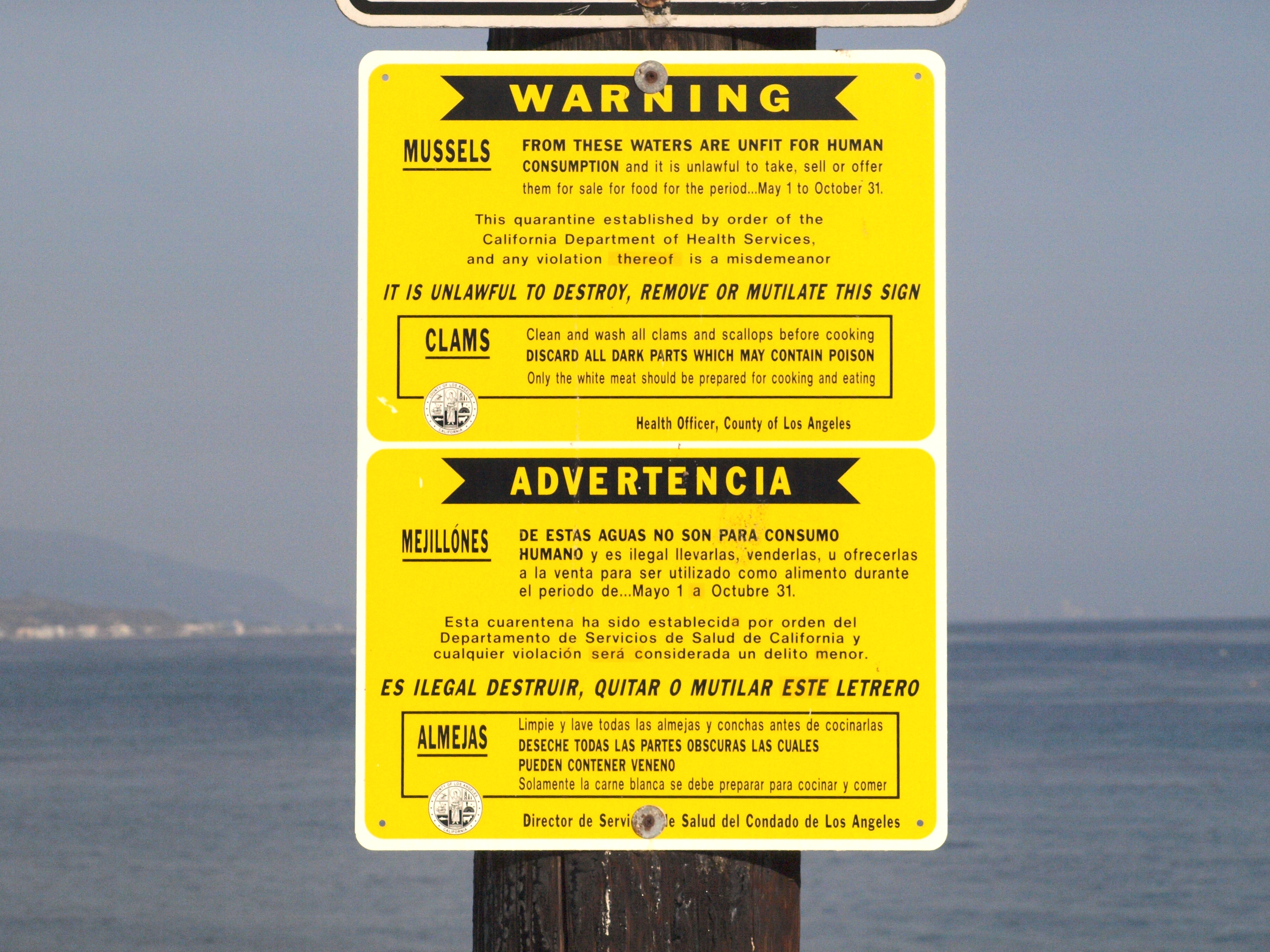
As reported later by the DFG California Department of Fish and Game, “Fishes began to aggregate around the Paradise Cove car body reef within hours of construction. Surfperch, sargo, kelp bass, and small California halibut were among the first fishes attracted to the reef, followed closely by sheephead and opaleye. Later, rockfish and sand bass appeared. The fish population on the reef increased, until a high of 24,000 semi-resident fishes was counted in September 1960. During a 30 month survey period, 49 species of fish were noted on Paradise Cove Reef.”
However, as might be predicted, the old automobile bodies were fairly quickly eaten away by the salt water. Today the reef has largely disappeared and reef-builders concentrate on longer lasting materials. I doubt if dumping wrecked cars into the sea would even be contemplated today. Environmental laws are much different and someone would undoubtedly protest. ”Something” in the auto would assuredly be seen as polluting the ocean.
<*}}}}}}}}}>< — Trailer camping? My how times have changed! According to a 1953 publication by the Fish and Game (Fish Bulletin #96), “This is a recently developed resort area catering to trailer camping, ocean fishing and bathing. There is a good sport fishing pier where skiffs are rented. There are hoists for launching and lifting skiffs and in 1952 there was an anchored fishing barge off the cove.” I’m afraid those days are over.
<*}}}}}}}}}>< — One of my most interesting visits to the pier took place in April of 2009 when I fished the pier with Hashem, a member of Pier Fishing In California. Hashem loves to pursue lobsters while I pretty much stick to fishing. The date was “Good Friday” and it seemed appropriate given the unending number of walleye surfperch that were out toward the end of the pier.
Thinking there must be something bigger to be had, I decided to use one of the walleyes as live bait. Pretty soon the rod took a dip and I knew a bigger fish was on than the aforementioned perch. I called for Hashem to grab his net but it turned out he already was bringing it up and inside was a legal-size lobster.
Soon after, I had a halibut to the top of the water and shortly thereafter the net, filled with a halibut and lobster, was pulled up to the pier. Unfortunately the halibut was only 19 ¾ inches long, short by a little over two inches. Alas, the lobster also was illegal since the season had just ended. I’ve never seen a net pulled up that contained the unusual duo—halibut and lobster—but both of the Southland prizes had to be returned to the water. Too bad; halibut and lobster are two of my favorite seafood’s.
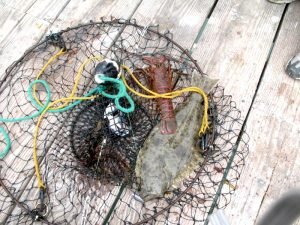
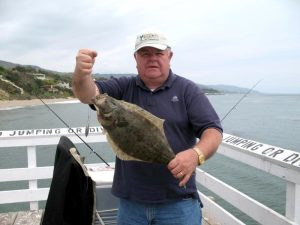
Just a little short!
<*}}}}}}}}}>< — One of my early visits to Paradise Cove started out a little strange when, as I stopped to pay the entry fee, the attendant asked “Going to the restaurant?” “No, I want to go fishing on the pier.” “Oh, you need to check to see if it is open today, they may be filming on the pier. Go down and ask the guard, he’ll know where the action is today.” Filming? Guards? What was going on? Turns out it was just another day in the life of Paradise Cove, its quintessential California beach, and this pier, a frequent setting for television shows, movies, commercials and music videos.
The cove may be best remembered as the home base for Jim Rockford (James Garner) in the The Rockford Files (originally shown in the ’70s and resurrected in the ’90s). Rockford’s humble trailer, given the fictional address “29 Cove Road,” was actually located in the parking lot of the Sandcastle Restaurant. A loyal legion of fans (including myself) will always remember Jim, his dad Rocky, his police contact Sgt. Becker, Jim’s girlfriend Beth, and cowardly sidekick “Angel” Martin (who was no angel).
A less known fact is that the first house to the right of the restaurant served as William Conrad’s house on Jake and the Fatman. The list of appearances in television series is long: Sea Hunt, Love American Style, The Mod Squad, Baywatch, Baywatch Nights, Charlie’s Angels, Happy Days, The Hardy Boys, Malibu Run and The O.C.
Movies include Belles on Their Toes, Wonderbug, The Last Tycoon, Listen to Me, Indecent Proposal, American Pie 2, House of Sand and Fog, Lethal Weapon 4 (the pier is seen in the background), Monster in Law, Alias, Gidget, Gidget Goes to Hawaii, How to Stuff a Wild Bikini, Beach Blanket Bingo, Sponge Bob Square Pants: The Movie, and Hannah Montana: The Movie.
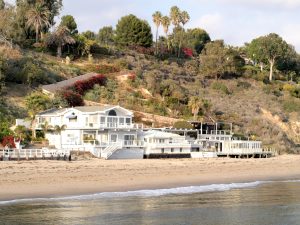
This home that sits just downshore from the pier has been used for many movies.
The pier also served as home base for one of my favorite low budget movies—Raymie. The movie, a B&W film made in 1960 concerns a kid trying to catch “Moe,” the legendary barracuda at the pier that’s been stealing fish. A mini-classic of sorts. You can see scenes at the following:
http://www.barthsburgery.com/fanpages/raymie60.htm
Commercials at the pier have included ones for Chrysler, Budweiser and many others. Hummer even did a commercial featuring a brand new Hummer heading full speed down the pier until it sailed off into the salty Pacific. I assume the saltwater must have been just a tad bit hard on the car. Then again, if you’ve got to sail off a pier in a car, what better protection than a great big, heavy Hummer?
Musical videos have also chosen the cove and pier as home. A Paris Hilton music video was filmed here (she can sing?), as was the Britney Spears video Sometimes in 1999. Doesn’t it just give you goose bumps and make you proud that Britney chose the pier as the site for her video? Of course there’s a long connection to music—Paradise Cove was on the album cover of the Beach Boys’ Surfin’ Safari.
In this same vein was a contact I made in 2006 while at an Outdoor Writers Association of California (OWAC) conference in Bishop. I had the pleasure of meeting a new member, Harry Medfed, and receiving an autographed copy of a book just published. The book was a guide to places in California used in movies and how to visit them. Of course we soon were talking about piers used in movies and exchanging information. The following section is from that book.
“The Paradise Cove Pier is a rickety, wooden structure built in 1945, often used by filmmakers searching for evocative seaside flavor. In 1952, it was the site of a Nantucket barbecue in the Cheaper by the Dozen Sequel, Belles on Their Toes, with Myrna Loy, Jeanne Crain, and Debra Paget. Robert De Niro takes Ingrid Boulting here for an outing in The Last Tycoon, where they meet local salt Seymour Cassel and his pet seal. The pier figures prominently in the opening flashbacks in Indecent Proposal, where Woody Harrelson proposes to Demi Moore. They are reunited on the pier in the moody fog-enshrouded finale.
For American Pie 2, production designer Richard Toyon re-created a Lake Michigan retreat, complete with beach house, sailboats, Midwestern flora, and a lakeside lighthouse (erected on the pier’s edge) where hormonally charged hero Jason Biggs almost gets lucky with Shannon Elizabeth. And in House of Sand and Fog, the pier plays a dramatic Northern California locale where Jennifer Connerly and Ron Eldard get to know each other over lunch.”
—Harry Medfed with Bruce Akiyama, Hollywood Escapes
<*}}}}}}}}}>< — Did you know that Bob Dylan played the role of Alfred, the chauffeur, in the 1999 movie Paradise Cove? Based upon the movie’s reviews, sounds like you shouldn’t waste your money renting the “film noir” movie it even if you are a “Bob” fan. It’s that bad. Nor should you mistake it for the equally bad 2008 horror movie Paradise Cove.
History Note. The cove was once the site of Sumo, one of the largest Chumash Indian villages in California. Given protection by Point Dume, and presented easy access to the Channel Islands, Sumo became a major center for both fishing and trade. Archeologists who have studied the site feel it was populated as far back as 8,000-9,000 years. The cove contains a cemetery dating back 7,000 years and is considered a sacred burial ground of the Chumash Indians.
As with every area along the coast, the cove was eventually taken over and claimed by Spain, before becoming Mexican and then Californian. The cove apparently was used as a port for some of the early “American” settlers in the area and became one of the areas through which the “Hueneme, Malibu and Port Los Angeles Railway” would run. Traces of that rail line can still be found adjacent to the Mobile Home Park Clubhouse. The cove became a favorite spot for picnics as well as fishing
The private cove has long been a favorite spot for locals, a place for picnics and fishing, as well as a haven for nude sunbathers and movie stars. In the 1940s the Marblehead Land Company subdivided the area creating the Malibu Riviera’s #1-4. The lower area, by the beach, was owned and initially developed by Frank Wilson and Al Camp. They oversaw the construction of a clubhouse (that eventually became the Sandcastle Restaurant) and a laundry/restroom building. However, their plans for additional development was stalled during the World War II years and in 1945 the property was sold to Bill Swanson
With the end of the war that year, Swanson soon began to finish the development of the area, including the trailer park that still sits just up the road from the beach. To attract “trailerists” he also built a number of attractions, most that would seem pretty tame today. Most of his early ads concentrated on the “trailer park” aspect of his property.
August 22, 1947 saw the following advertisement appear in the Los Angeles Times:
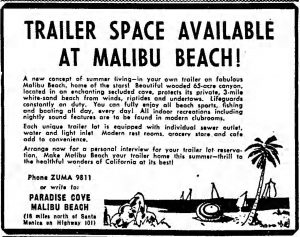
An ad in the Palm Springs Desert Sun in April 8, 1949 tried to attract desert dwellers:
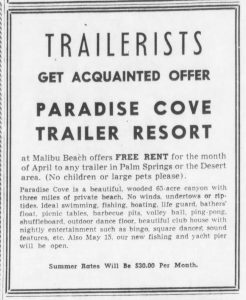
Another ad, from 1948, offered Trailerists a get acquainted offer at the Paradise Cove Trailer Resort
At the same time, Swanson began to focus attention on Paradise Cove as a recreational center.
On July 22, 1949 the following appeared in the Los Angeles Times:
Paradise Cove Beach Club — Malibu Beach
Now open to the public. Three miles of private beach. No winds or rip-tides. Rest rooms, showers, dressing rooms, picnic grounds, pier fishing, boats for rent.
Admission 75 cents — Free Parking
Most important for our story was the construction of a pier in the cove. History isn’t clear, was it eventually an 820-foot-long pier or a 600-foot-long pier? What is clear is that it, like most piers, suffered occasional storm damage that required repair and modification over the years. Nevertheless, the pier has continued to grace the cove’s waters since 1949.
New Roadstead
Comes now a new sailing roadstead for Southland skippers—Paradise Cove, 16 miles north of Santa Monica. Since last summer Sabot dinghy sailors of the Malibu Yacht Club have raced there. This week however, Bill Swanson announced construction of a 400-foot pier. —Los Angeles Times, March 20, 1949
In the early ‘50s, the cove was purchased by Joe Morris who himself sold it a decade later. Morris developed the pier into one of the main centers for Sportfishing in the area and offered up a variety of fishing opportunities: full day boats, half-day boats, and barge fishing (the Buccaneer, Lady Luck and Paradise). Both a tackle shop and small snack bar were found out toward the end of the pier. 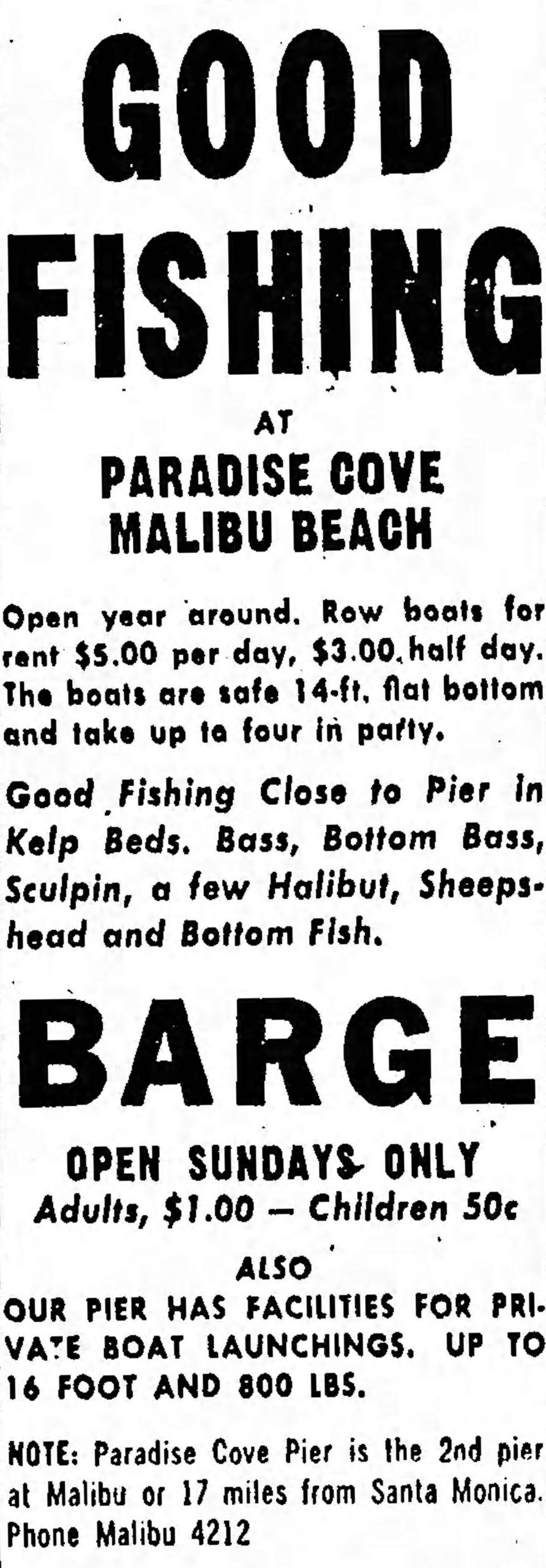
Los Angeles Times, November 17, 1950
Fishing News
Paradise Cove, Malibu Beach. Pier now opens at 3 A.M. Private boat launching in and out, including free parking, $3.00. Flat bottom non-sinking row boats for rent, $3.00 half day—$5.00 full day. Take four fishermen. Two barges open daily from 7 A.M. to 5 P.M. Shore boat every hour on the hour. Kelp barge $1.00 person. Deep Sea barge $2.00 person. Kelp beds, rocks and reefs close by make ideal fishing grounds. Bait and tackle stand, café. Don’t forget for private boat launching and boat rentals pier now open 3 A.M. —Los Angeles Times, June 5, 1953
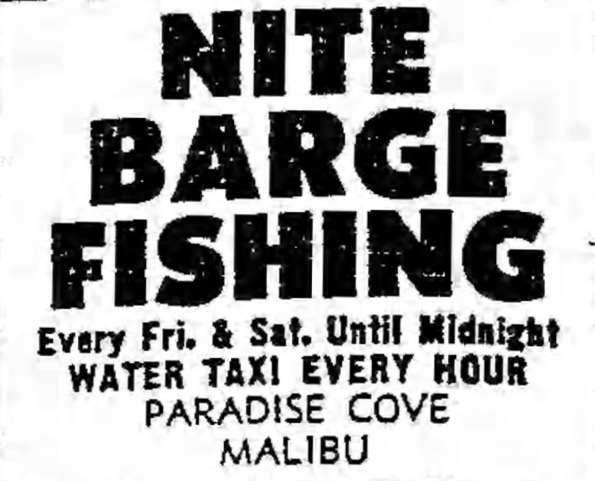
Los Angeles Times, July 31, 1953
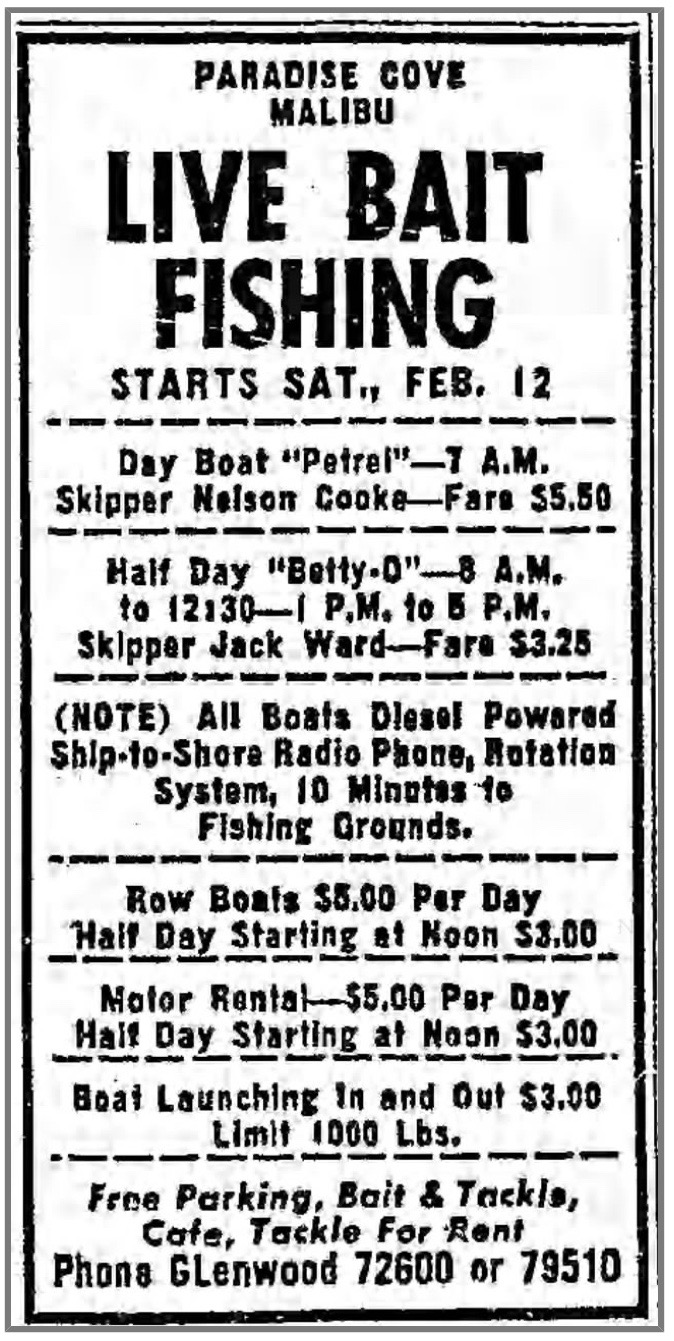
Los Angeles Times, February 10, 1955
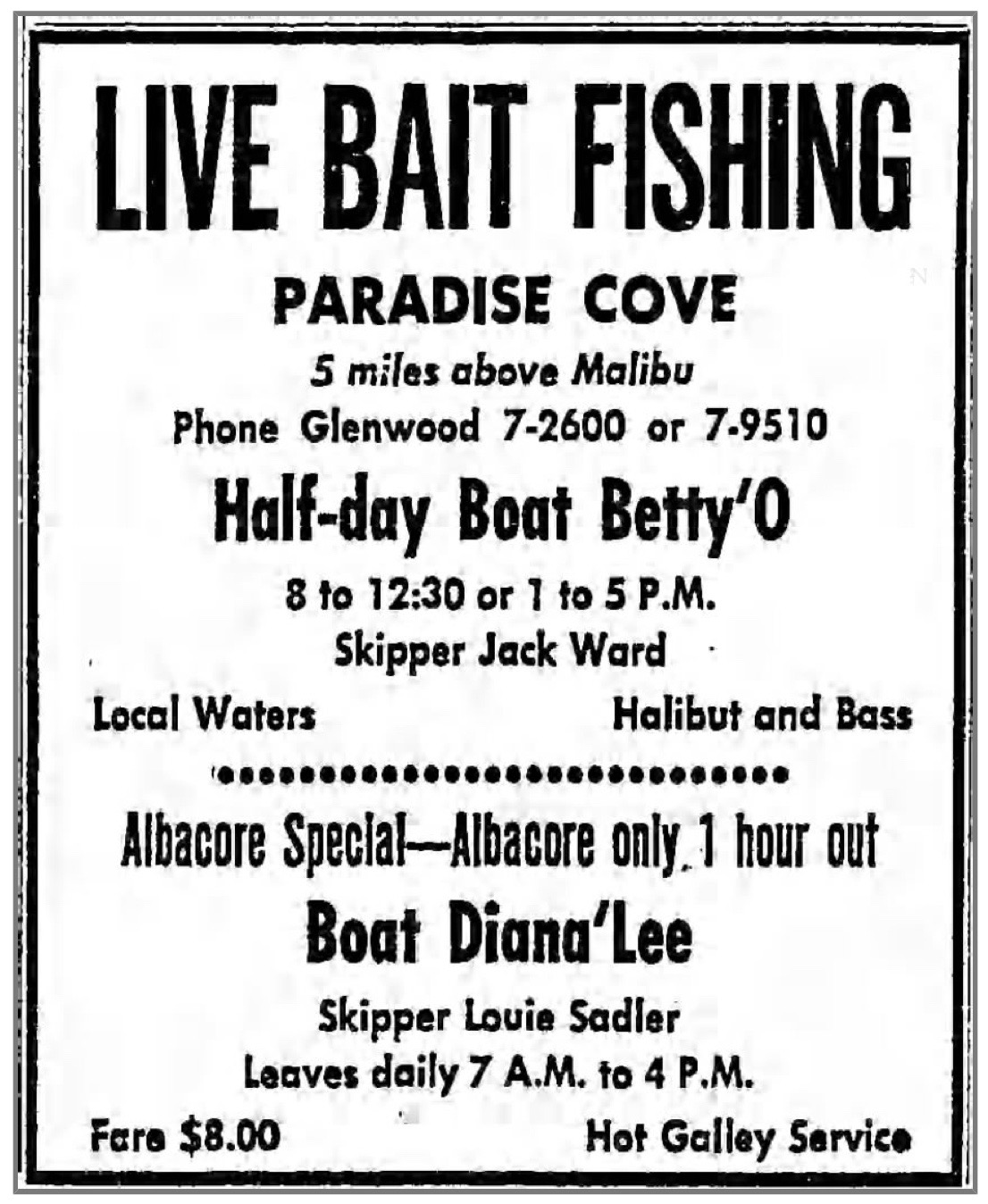
Los Angeles Times, August 13, 1956
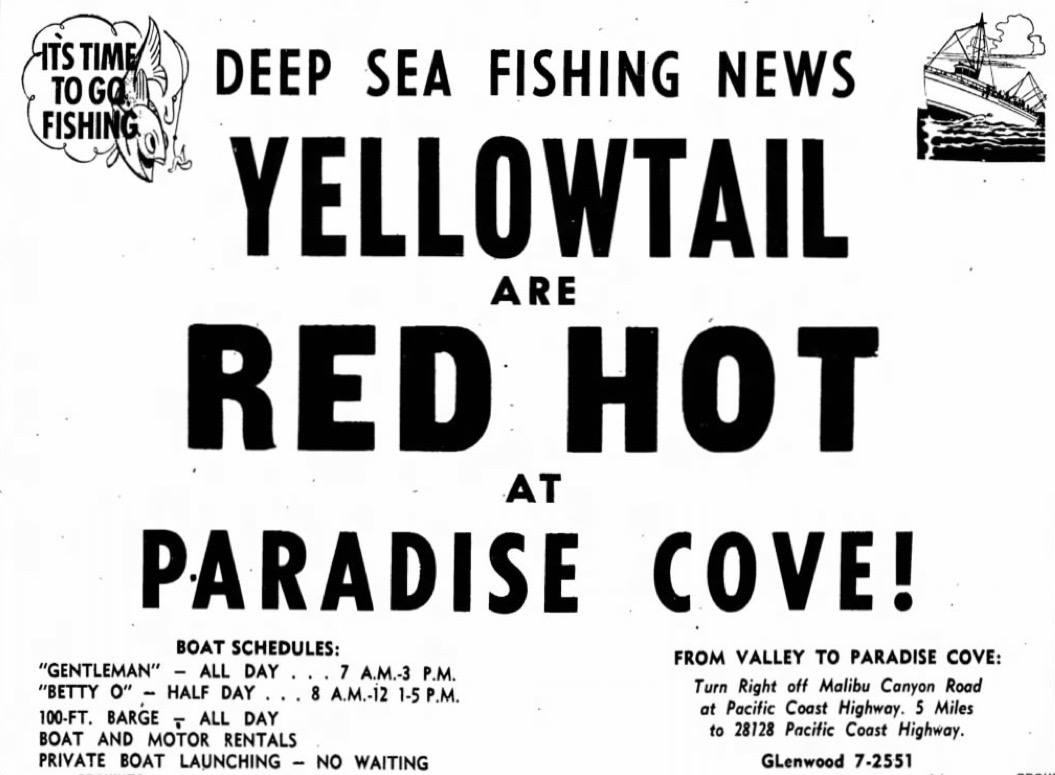
Van Nuys News, September 26, 1958
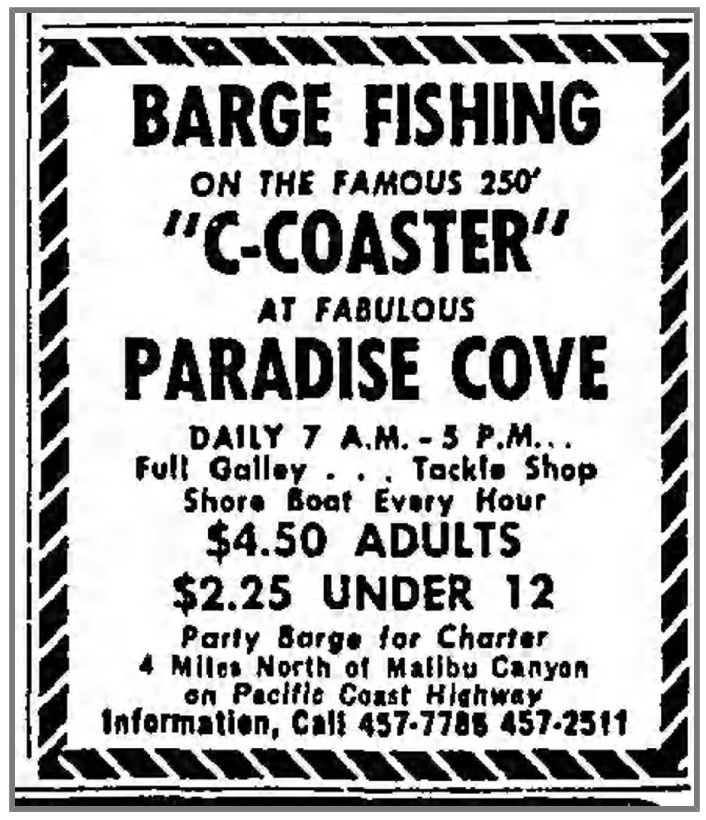
Los Angeles Times, July 28, 1966
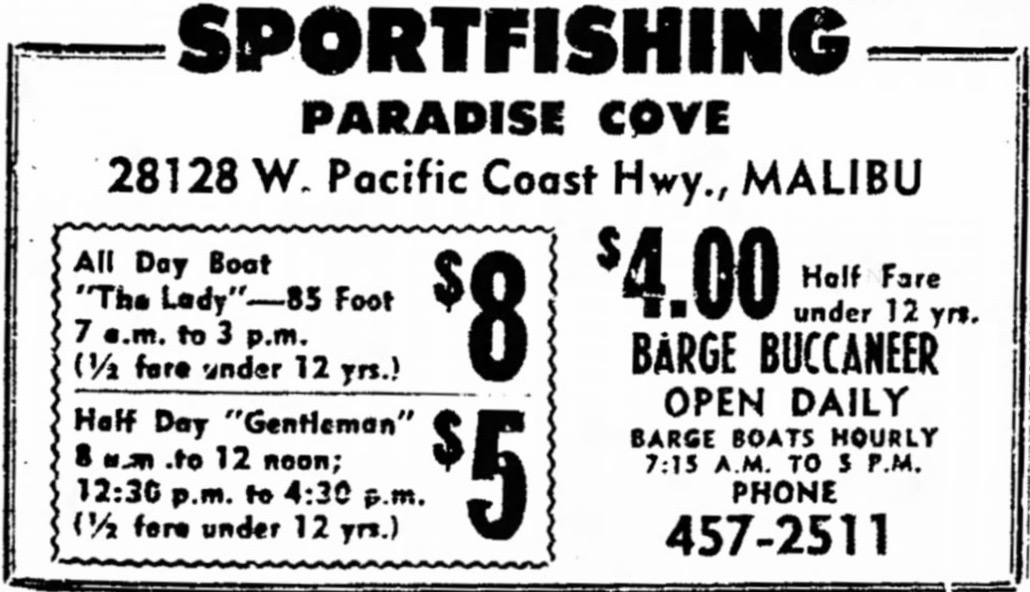
Valley News, September 1, 1967
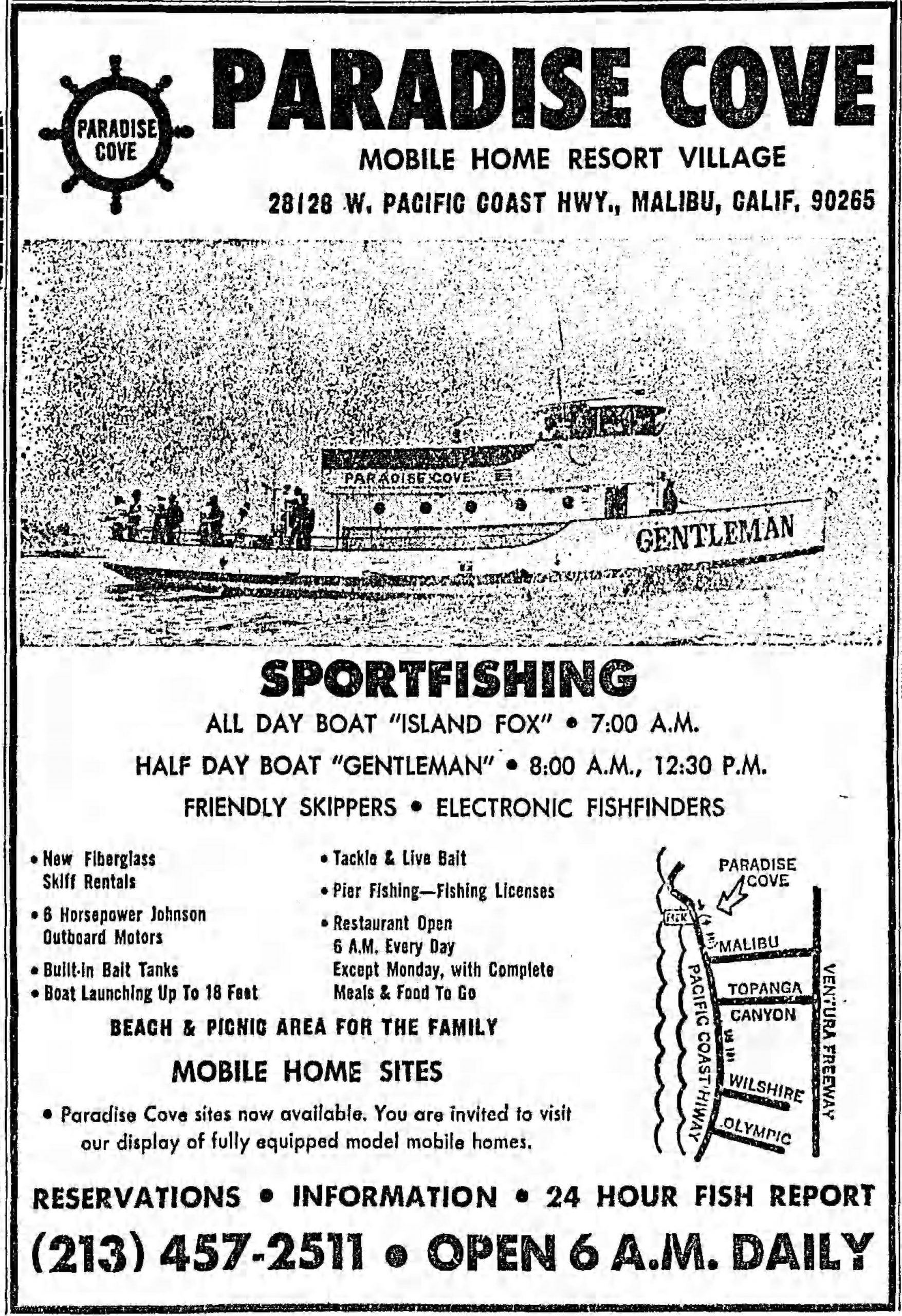
Los Angeles Times, February 12, 1971
Joe Morris’ son Robert spent part of his youth working in his father’s sport-fishing business. Years later, after becoming one of LA’s most successful restaurateurs (26 restaurants including his most famous—Gladstone’s), he would return to the cove.
On my first visit to the cove, in the late ‘70s, I was presented a quite different picture from the one a person sees today. The restaurant my wife Pat and I visited, the Sandcastle Restaurant, had a Cape Cod décor with thick red leather booths and a traditional, non-hip LA menu. The food was good and reasonably priced.
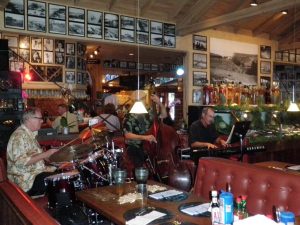
As for the pier itself, it was fairly long and was home base for the Paradise Cove Sportfishing fleet. Boats included the half day boat Speed Twin and the all day boat Gentleman. Lined up in a neat row on the deck of the pier was a fleet of rental skiffs.
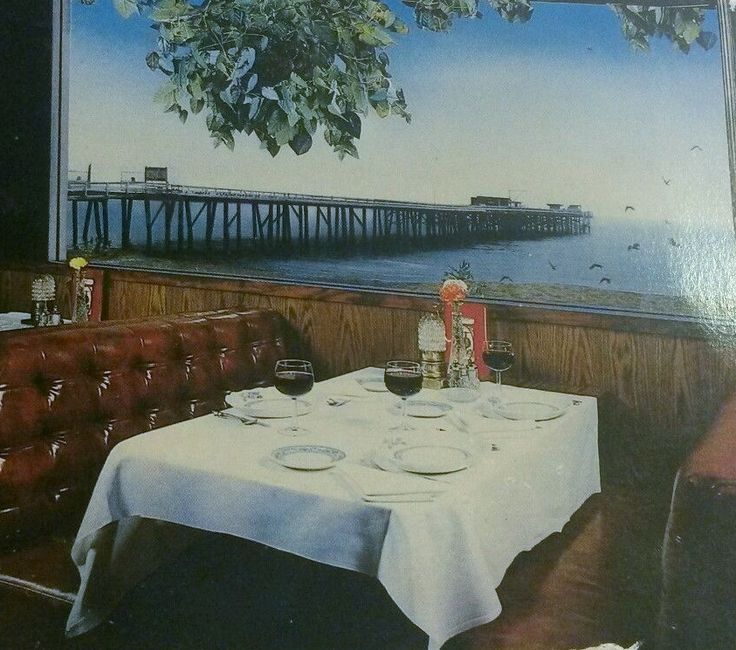
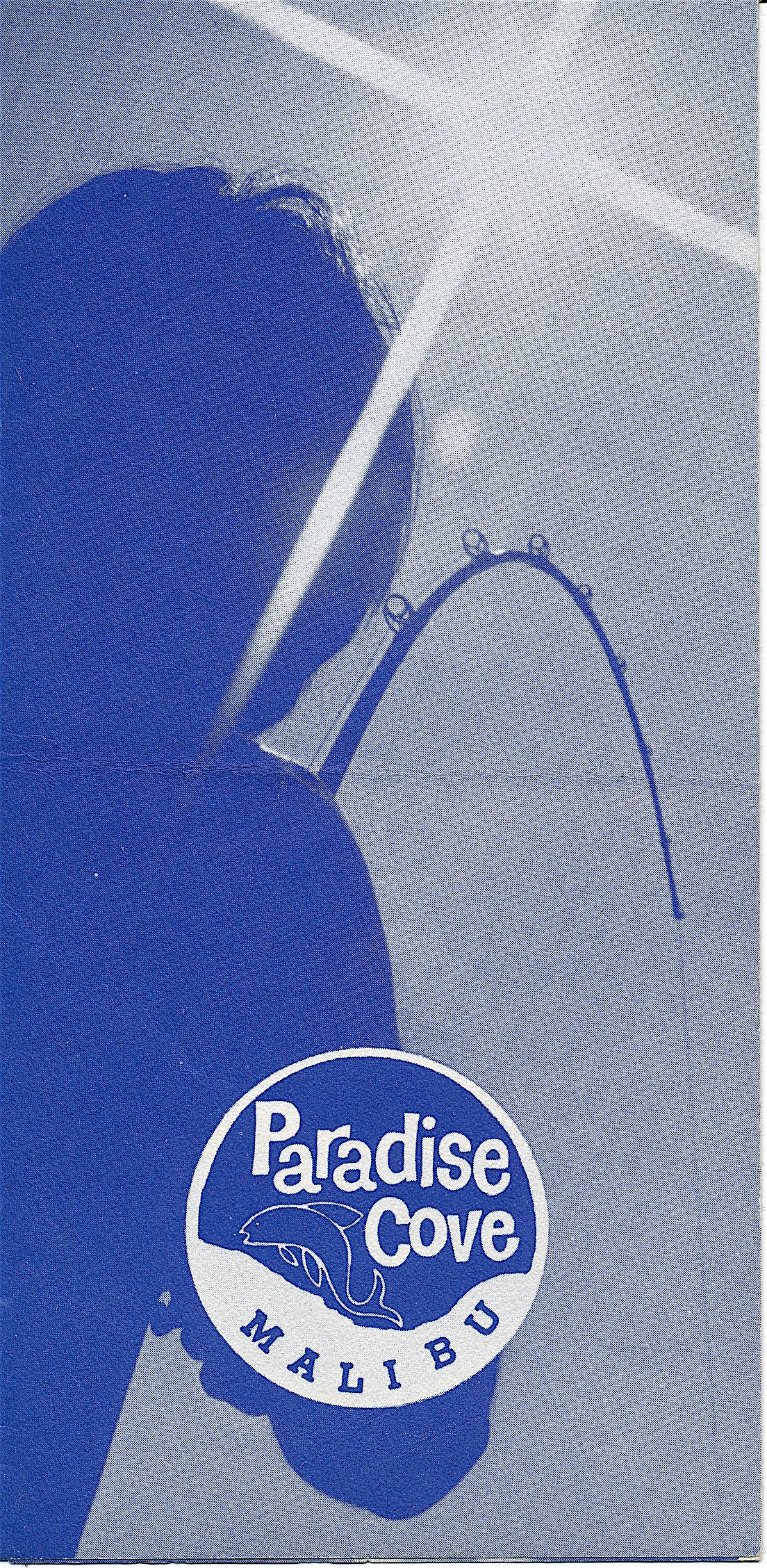
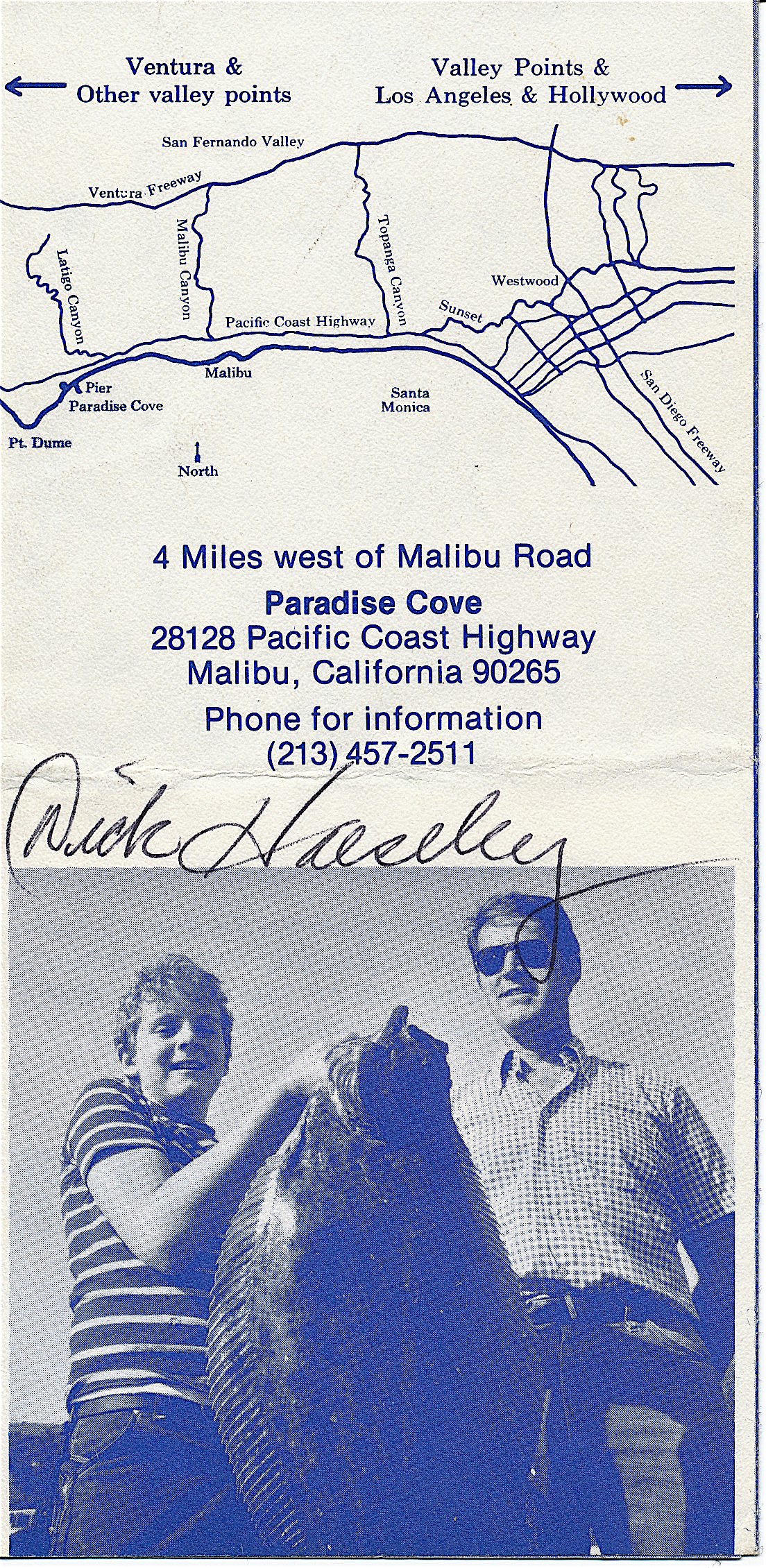
The 600-foot-long length of the pier mentioned in 1983 appears to have been a result of storms prior to that year. However, the El Niño storms of 1983 destroyed much of the remaining pier (roughly two thirds) and brought an end to the deep sea fishing operation as well as the bait barge and the (reported) 87 sea lions that used it as a home.
Little change has taken place at the pier since those storms of ’83. The pier is still short but has been strengthened and spruced up with fresh boards and paint. On shore, the Sandcastle Restaurant has been replaced by the Paradise Cove Beach Café, a creation of Robert Morris who did indeed return to the area where he had spent so much of his youth.
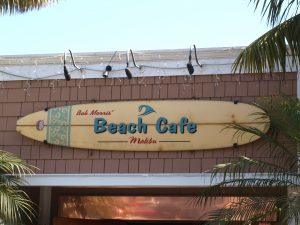
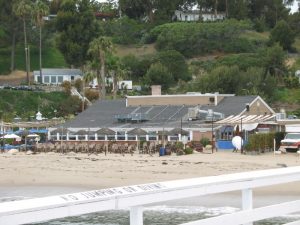
Given the past history of this pier, and the excellent fishing that can take place, it is hoped that sometime in the future this pier can be reconstructed to a longer length. Although open until 2000, it was closed for a period of time between 2001-2006. It is now open but, as mentioned, is still a ghost of its former self.
Paradise Cove Pier Facts
Hours: Unfortunately this is the land of those that have and the parking rates reflect it. Beach parking is $45 (Mon-Fri) and $65 (weekends and holidays). However, if you spend a minimum of $30 at the Paradise Cove Beach Café near the beach you receive a validation that entitles you to a cafe parking rate of $10 (Mon-Fri) and $15 (weekends and holidays). The validation is good for four hours. Although the food is pricey it is generally good and the portions generous. It is possible to park for free out on PCH, and walk down the mile-long access driveway, but you will stay pay (I believe) a walk-in fee ($5 per person last time we checked). There are restrooms in the cafe and tables near the beach but they are for PAYING customers.
Handicapped Facilities: None.
Location: 34.02020803359893 N. Latitude, 118.78626108169556 W. Longitude.
How To Get There: Take Highway 1 to Paradise Cove Dr., turn west, and follow the road back into the parking lot.
Management: Private.
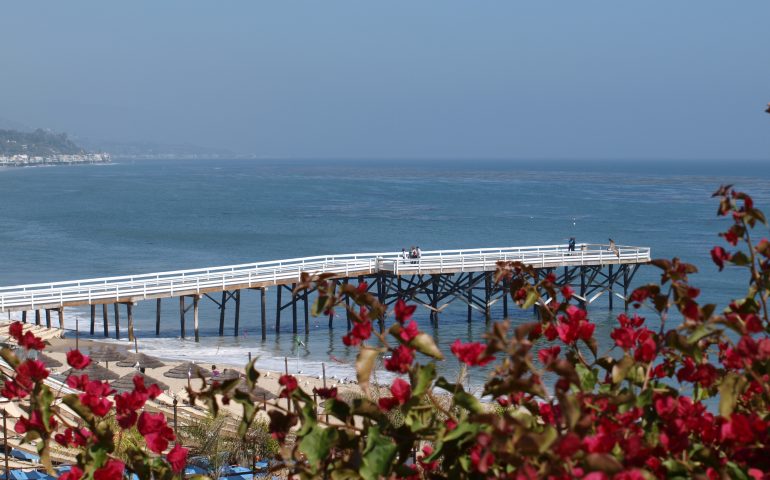
Hove lovely to read about home.
how come nobody ever mentions the island fox i had good trips on that boat in the 70’s’
I worked as the deckhand on the Island Fox,
with skipper Ed Comfort in in 1972, 73, and
74, and was three of the best years of my life.